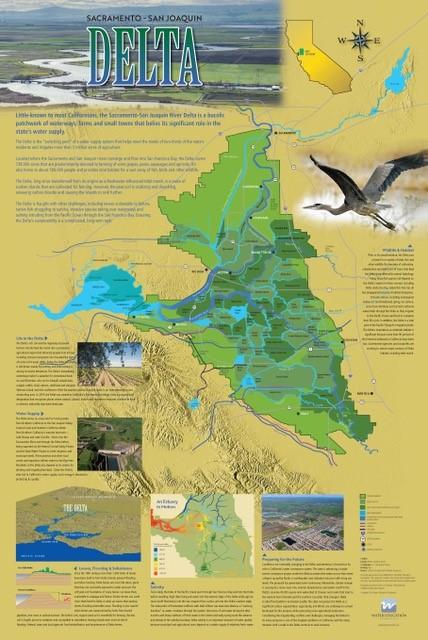California Project WET Gazette
Spring 2024
Smokey Bear and Nature’s Ecosystem Engineer
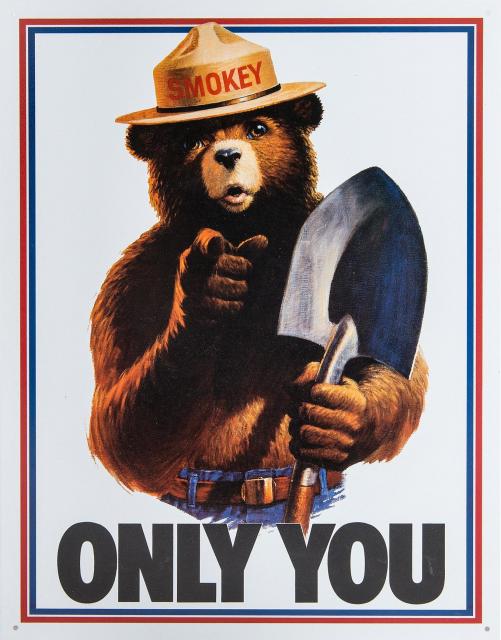 “With a ranger’s hat and shovel and a pair of dungarees, you will find him in the forest always sniffin’ at the breeze,” as the old U.S. Forest Service jingle goes, Smokey Bear is second only to Santa Claus as the most recognized popular culture figure in the United States. Born out of a World War ll ad campaign after a Japanese submarine attack near Santa Barbara, Smokey’s message of “Only you can prevent forest fire” is one of the most successful and longest-running public media campaigns in U.S. history.
“With a ranger’s hat and shovel and a pair of dungarees, you will find him in the forest always sniffin’ at the breeze,” as the old U.S. Forest Service jingle goes, Smokey Bear is second only to Santa Claus as the most recognized popular culture figure in the United States. Born out of a World War ll ad campaign after a Japanese submarine attack near Santa Barbara, Smokey’s message of “Only you can prevent forest fire” is one of the most successful and longest-running public media campaigns in U.S. history.
Yet, it was becoming clear by the end of the last century that Smokey’s message was not keeping up with current science or thousands of years of Native American knowledge on the role of fire in maintaining ecosystems in California and throughout North America. Even as Smokey’s popularity took off like a firestorm in the 1940s and 1950s, a less charismatic but real-life mammal was being parachuted into remote parts of El Dorado National Forest east of Sacramento and other national forests in the West to battle a different environmental threat – the drying of meadows.
Unlike the World War II paratroopers that inspired the air drops, this sharp-toothed, paddle-tailed animal needed no training or equipment to carry out its mission of building dams to restore wetlands critical for wildlife and biodiversity.
You may have already guessed that the Smokey Bear rival is the beaver, which is featured in the original Project WET Guide activity “Water Address” and more advanced California version of the activity. The activities engage students in learning how organisms adapt to their environment, with the California version highlighting organisms’ responses to a changing climate.
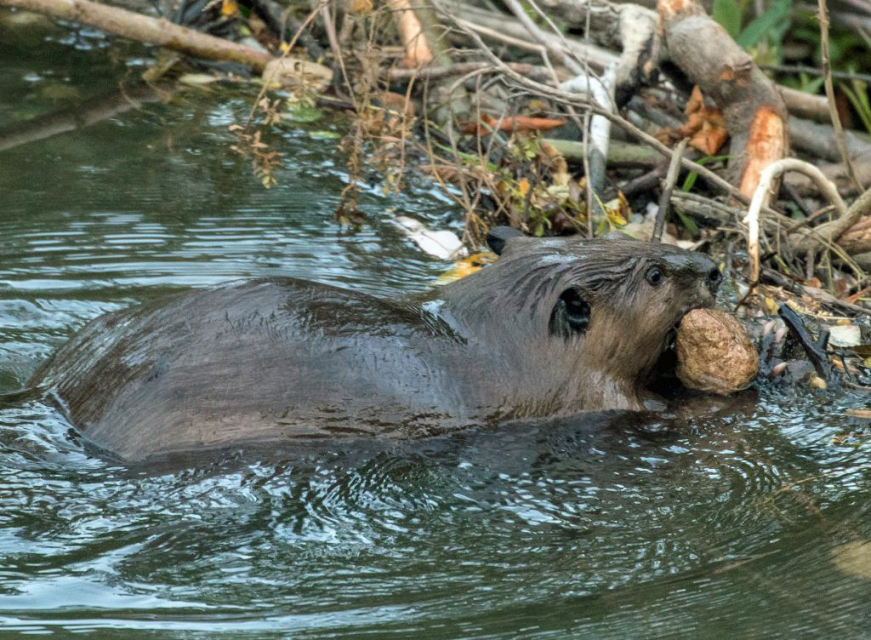 The beaver is second only to humans in its ability to alter landscapes, with forelimbs well designed for excavating and ever-growing, razor-sharp teeth perfect for felling small trees. Beaver-engineered wetlands once covered as much as one-tenth of North America and played as much of a critical role in the cycling of water as wetlands, floodplains, meadows, and forests.
The beaver is second only to humans in its ability to alter landscapes, with forelimbs well designed for excavating and ever-growing, razor-sharp teeth perfect for felling small trees. Beaver-engineered wetlands once covered as much as one-tenth of North America and played as much of a critical role in the cycling of water as wetlands, floodplains, meadows, and forests.
The semi-aquatic rodent builds dams to create deep-water ponds that protect them from predators and raise water levels so they can swim to the riparian vegetation that is their source of food and building materials.
Beaver-made wetlands provide a multitude of ecosystem services, from habitat diversity for wildlife to water purification and fire suppression important to people. Those benefits became apparent by the early 20th century when their population had greatly diminished. Excessive fur trapping had taken a big toll as did the destruction of beaver dams to open land for farms and homes and the killing of beavers to protect crops and reduce flood risks.
In 1911, the California Legislature passed a law to protect the remaining beaver. Wildlife officials tied the beaver eradication to environmental degradation and began live-trapping and planting the rodents in watersheds across the state in 1923.
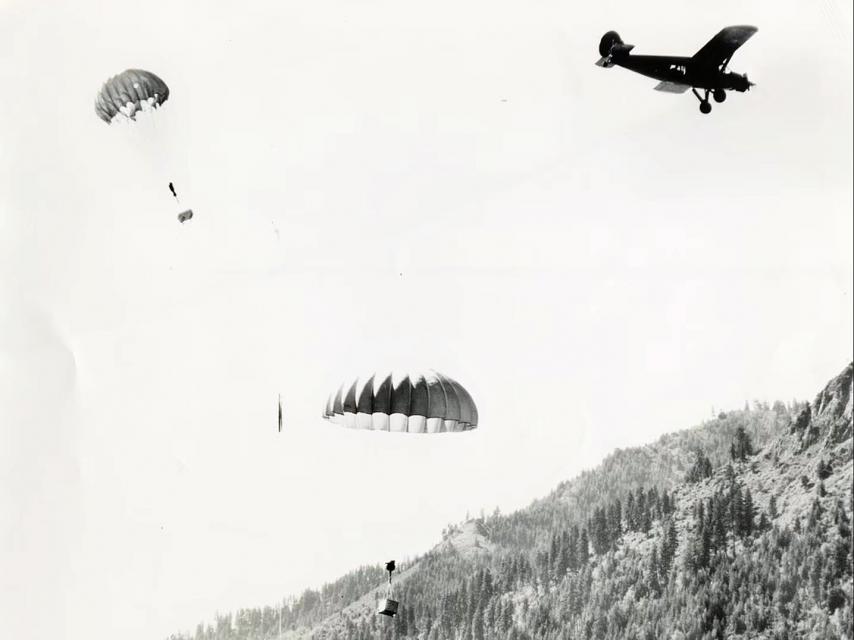 As one biologist noted in a 1942 Fish and Game report, “It is now understood that soil erosion and shortage of water in some places resulted from the destruction of the beavers, which formerly built, and kept in repair, dams on the upper reaches of many streams. The dams were the effective means of impounding waters of the spring runoff, and of distributing them slowly downstream throughout the Summer.”
As one biologist noted in a 1942 Fish and Game report, “It is now understood that soil erosion and shortage of water in some places resulted from the destruction of the beavers, which formerly built, and kept in repair, dams on the upper reaches of many streams. The dams were the effective means of impounding waters of the spring runoff, and of distributing them slowly downstream throughout the Summer.”
Reintroducing beaver to restore wetlands advanced wildlife officials’ goal of sustaining healthy populations of deer, elk and fish for hunters and anglers. Beavers also help to control soil erosion, which was a national mandate in the aftermath of the Dust Bowl, as was protecting water resources for livestock and cropland downstream.
The critical role of beavers was apparent elsewhere in the West. Inspired by World War II airborne tactics Idaho’s Department of Fish and Game in 1948 parachuted 76 beavers in remote mountainous areas. California wildlife staff followed suit in 1950, air-dropping beavers into the El Dorado National Forest between Sacramento and Lake Tahoe
By the end of 1950, California had banned the translocation of beavers. It was believed the rodents spread giardia and other waterborne diseases. Farmers worried about beavers damaging crops and communities feared the upstream beaver dams posed a flood risk. Research on beavers has since led to practices that mitigate these concerns.
Beavers continue to get a bad rap, but studies continue to show they are skilled ecosystem engineers capable of rapidly restoring and creating wetlands that actually alleviate flooding, improve water quality and boost biodiversity.
Beaver dams slow stream flows, allowing water to release sediment. The sediment fills eroded sections of streams, reconnecting them with their floodplains. The rewatered floodplains in turn support the growth of deciduous riparian vegetation that feed beaver, deer, elk and other creatures, including aquatic insects in their nymph and larval stages eaten by fish. These areas can transition into drier meadows that grow grasses, forbs and other plants favored by rodents and insects, which form the base of the food chain for a vast array of species.
The result is greater water infiltration and storage in the stream and the surrounding soils for recharging groundwater and sending a steadier, longer and cleaner supply of water flowing downstream into the dry season. One study in the Pacific Northwest found that in rain-dominated basins, beaver ponds increased summer water availability by up to 20 percent. This beaver-generated system is a natural buffer against drought and slows and captures stormwater.
Beaver-engineered wetlands are also critical firebreaks. They have survived mega-fires across the West, protecting water resources and wildlife in otherwise incinerated landscapes. In 2022, California introduced new policies embracing beavers to help check the spread of wildfires and reactivating the beaver translocation program – sans parachutes.
The better 21st-century American mascot of wildfire prevention may well be a beaver, as it is in Canada with Bertie the Beaver. But, at 80 years old, Smokey may not mind sharing the spotlight with another eager beaver.
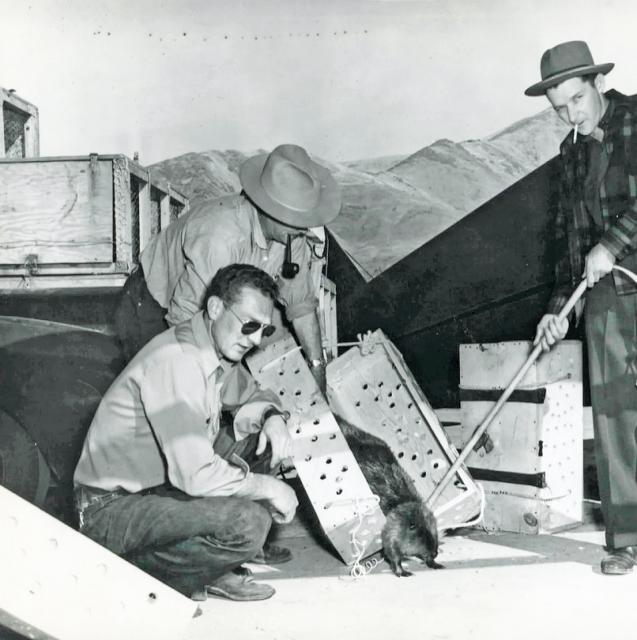 On a final note, you may still be wondering how exactly those beaver airdrops worked. The Idaho crew designed a wooden box that would open upon impact. They tested it first with some weights, then with an older male beaver “test pilot” they named Geronimo. After multiple drops with Geronimo successfully climbing out of the box, platoons of beavers were dropped by parachute into what today is the Frank Church River of No Return Wilderness Area.
On a final note, you may still be wondering how exactly those beaver airdrops worked. The Idaho crew designed a wooden box that would open upon impact. They tested it first with some weights, then with an older male beaver “test pilot” they named Geronimo. After multiple drops with Geronimo successfully climbing out of the box, platoons of beavers were dropped by parachute into what today is the Frank Church River of No Return Wilderness Area.
Parachuting beavers is certainly a phenomenon that will arouse students’ curiosity in introducing activities like “Water Address.” I hope this column raises your own curiosity and understanding of an animal whose value in softening the effects of climate change goes well beyond the price of its fur.
Read more about the roles of beavers in California and Smokey Bear in the Websites of Interest section of this Gazette. Review the Events to learn about International Beaver Day and other spring opportunities. There are also a variety of upcoming Grants and Student Contests. I’ll also encourage everyone to attend one of our workshops this spring or California Water Institutes this summer. You will find more about these workshops in the Professional Development section of this Gazette
Hope you have a wonderful spring!
WEBSITES OF INTEREST
NPR: Parachuting beavers into Idaho’s wilderness? Yes, it really happened
More than 60 years ago, Idaho Fish and Game dropped beavers out of a plane and parachuted them into the state’s backcountry. This little-known piece of Idaho history stars a crafty Fish and Game officer and a plucky male beaver named Geronimo.
Smithsonian: A Brief History of Smokey Bear, the Forest Service’s Legendary Mascot
The United States had been living in fear of devastating forest fires since before World War II when fire was seen as a weapon of war. And since the war, we’ve had Smokey Bear, sweetly but insistently reminding each of us of our role in protecting the country from this danger: “Remember—only you can prevent forest fires.” But what if Smokey was sending the wrong message?
Fire on the Landscape: Bear in Mind the Beaver
In the U.S., no animal is more universally associated with forest fire prevention than the iconic Smokey Bear. Decades later, however, we know that a strategy of all-out fire prevention and suppression actually helped create conditions for the mega-fires of today. When it comes to a more balanced approach to fire management in the forest, perhaps we ought to be lauding another critter: the Beaver.
California Department of Fish & Wildlife: Beaver
This CDFW webpage has great information on beaver ecology and on their role in engineering wetland environments. It also provides current information on practices and laws pertaining to beaver management in California. Click here to see an op-ed by CDFW Director Charlton H. Bonham titled: We Agree: Time For California To Embrace Beavers.
California Waterboards: A Progress Report on Beaver Management in California
This is an amazing 13 page scanned copy of a 1946 California Department of Fish and Game report on beaver management and history that our Deputy Director Chris Bowman discovered on the California State Water Resources Control Board records.
PBS: Leave it to Beavers
Using their skills as natural builders and brilliant hydro-engineers, beavers are being recruited to accomplish everything from finding water in a bone-dry desert to recharging water tables and coaxing life back into damaged lands.
Bay Nature: Believing in the Power of Beavers
Washington state began re-embracing beavers in the late 1990s and early 2000s, motivated by their ability to support declining salmon health as various lethal beaver management strategies were outlawed. Oregon, Wyoming, Utah, and most other western states have followed suit. Last year California finally jumped on the beaver bandwagon.
High Desert Museum: Dam It! Beavers and Us
This virtual experience forms part of Dam It! Beavers & Us, an exhibition by the High Desert Museum open through October 3, 2021. The North American beaver, Castor canadensis, transforms the landscape and creates habitat for other native species. Many ecologists call it an ecosystem engineer. This animal also plays an important role in human history and culture. Dam It! Beavers & Us explores the interrelationship of people, beavers and the landscape.
BBC: The US is bringing back nature’s best firefighters: beavers
Beavers are vital to ecosystems, as their dam-building habits spread water through parched landscapes. This can not only help to regulate the flow of water, it provides another important service – keeping fires under control. Beavers are nature’s firefighters.
ABC 10: Here is how beavers are helping in California’s firefight
California’s drought is a multi-billion dollar issue that we’ve dumped a lot of resources into, but climate scientists are finding that working with what nature provides could be more effective than our synthetic solutions. They say sometimes, you just gotta leave it to the beavers.
CBS News: ‘California reintroduces beavers into Plumas County waterway to renew ecosystem’
The California Department of Fish and Wildlife has reintroduced beavers into the wild for the first time in nearly 75 years, in cooperation with the Mountain Maidu tribe of Plumas County, to revitalize the local ecosystem and to act as a buffer during wildfires. Click here to see an aerial view of beaver ponds on Little Last Chance Creek that survived the nearly 1 million-acre Dixie Fire in 2021.
Valley Voice: Tule River Tribe reintroducing beavers to Tulare County
Sometime this spring, beavers will return to the ancestral lands of the Tule River Tribe in the Southern Sierra Nevada. It will be a moment tribal leaders have spent a decade preparing for, hoping the once thriving and now missing aquatic rodent can help return the forest’s natural drought resistance.
San Luis Obispo Tribune: Off-roaders damage SLO County beaver dam as battle over Salinas River brews
In mid-July — about six days after the beavers seemed to have completed their engineering feat — the game camera captured the loud snapping of sticks and a car’s roaring engine as it cut through the evening silence, its driver revving it up in an attempt to drive over the dam. After the unsuccessful attempt to drive over the dam, the passengers got out of the car and began tearing apart the beaver dam with shovels.
The Atascadero News: Atascadero unveils interpretive panels celebrating local beaver population
Nature lovers of all kinds headed out to the Juan Bautista De Anza Trailhead on Feb. 10th for the unveiling of two interpretive panels highlighting Atascadero’s beaver population and the benefits they bring to our community. Click to see a beaver dam on the Salinas River among fall colors.
Occidental Arts & Ecology Center: Beaver in California: Creating a Culture of Stewardship
The Occidental Arts and Ecology Center WATER (Watershed, Advocacy, Training, Education, Research) Institute has been working for two decades to develop innovative, science-based solutions to the hydrologically destructive land-use practices and policies affecting California’s watersheds, and address the impacts of climate change on the water cycle.
Texas Real Food: Protecting Crops from North American Beaver
Addressing the conflicts between beaver activity and agricultural interests requires a balanced approach that protects the natural behaviors of beavers while securing crops from damage. This necessitates a thorough understanding of beaver ecology and proactive management plans that allow for coexistence.
High River Online: Walt Disney’s gift to Alberta turns 65
Bertie Beaver turns 65 this year. The cartoon beaver character is Alberta’s answer to Smokey Bear; a wildfire prevention mascot who teaches kids the importance of preserving our forests. It may come as a surprise to hear that his origins start with Walt Disney.
US Geological Survey: Water Science
Learn about USGS research on the impact of wildfire on water resources in the west and on beaver-related stream restoration strategies, the ability of beaver riparian ecosystems to modulate streamflow and effects of beaver dams and ponds on urban streams.
California Department of Water Resources: Education
We provide a variety of resources to K-12 educators to encourage water education in and out of the classroom. Our free supplementary materials can be used to help learn about California’s water resources. Check out our ‘Water Wednesdays’ You Tube page for conversations with DWR researchers on a range of water topics.
PROFESSIONAL DEVELOPMENT OPPORTUNITIES
California Project WET Workshops
Join us this spring for Project WET workshops focused on increasing your knowledge of water science and management, water careers and current water challenges in California and the world – and how to use the interdisciplinary activities of Project WET to engage K-12 students through the lens of water to increase their environmental literacy.
Upcoming workshops in Riverside, Kern and Merced counties – plus a workshop and field experience for educators in who have previously attended a Project WET workshop!
California Water Institutes for Teachers
These multi-day professional development experiences for K-12 teachers focus on the water infrastructure and supply that serve the local area of each institute, while providing teachers with a greater depth of knowledge and tools to engage students in learning about their local watersheds and development of their environmental literacy about the places where they live and recreate. Participants will also receive Project WET training, be able to earn credit through CSU Chico, and an opportunity to receive a $400 stipend. Our 2024 institutes will occur in Butte, Sacramento and Solano Counties!
Forestry Institute for Teachers
Enjoy a week with natural resource professionals and advocates gaining a deeper understanding of forest ecosystems and human use of natural resources. Participants receive a high-quality professional development experience focused on interdisciplinary content and practices at the heart of current forest issues – as well as Common Core and Next Generation Science Standards. You’ll leave with a wealth of environmental education curriculum- including Project Learning Tree and Project WET!
Part of the Outdoor Learning Virtual Workshop Seasonal Series this workshop will offer practical ideas and resources for educators to teach about water. Registration is FREE and all registrants will receive a discount code to access outdoor learning resources when they register. Workshops are 60 minutes and will take place at 4pm Pacific / 7pm Eastern. Following the workshop, participants will receive a link to access a Certificate of Attendance.
California Environmental Education Interagency Network
This is a consortium of environmental educators representing state departments and partner organizations. Educators can find a variety of workshops and other participatory opportunities on our online events calendar to increase their environmental literacy on California natural resource topics and issues.
SPRING EVENTS
March 22: World Water Day
The theme ‘Water for Peace’ is all about how we can create a positive ripple effect – fostering harmony, generating prosperity and building resilience to shared challenges – when we cooperate on water. We must act upon the realization that water is not only a resource to be used and competed over – it is a human right, intrinsic to every aspect of life.
March27-28: Children’s Water Education Festival
The Orange County Water District (OCWD) is proud to present the award-winning Children’s Water Education Festival. The Festival presents a unique opportunity to educate third, fourth and fifth grade students about local water issues and the environment and helps them understand how they can protect water supplies and their environment.
April 7: International Beaver Day
Help people learn about these amazing animals on International Beaver Day! A fine time to hike to a beaver pond, arrange a display of books in your library, show a beaver video, and/or otherwise spread the word about nature’s ecosystem engineer!
April 22: Earth Day
Our theme, Planet vs. Plastics, calls to advocate for widespread awareness of the health risks of plastics, rapidly phase out all single-use plastics, urgently push for a strong UN Treaty on Plastic Pollution, and demand an end to fast fashion. Join us as we build a plastic-free planet for generations to come!
April 20 – 28: National Park Week
Love national parks? Join us for National Park Week, a nine-day celebration of everything “parks”. Entrance fees will be waived on April 20, 2024, to kick off the celebration and to encourage everyone to enjoy their national parks in person. National Park Service parks, programs, and partners will host events and activities all week!
April 26 – May 5: City Nature Challenge
City Nature Challenge is an annual four-day global bioblitz at the end of April, where cities are in a collaboration-meets-friendly-competition to see what can be accomplished when we all work toward a common goal.
May 1 – 31: California Water Awareness Month
California is experiencing climate shifts that bring more extreme weather, resulting in a massive swing of our driest three years on record moving into some of the wettest weeks in recent history. Despite these storms, we are still in a drought. Simple actions we can take right now will help save water and add up to a better future!
May 2: Big Day of Giving
Big Day of Giving, a 24-hour online fundraising giving challenge. Your gift can help us train more Project WET facilitators and expand our workshops to educators throughout California. You can learn more at our Big Day of Giving page. Thank you for being part of the Project WET community!
May 3 – 5: AEOE Statewide Spring Conference
Join the Association for Environmental and Outdoor Education for a weekend of learning, networking, and fun in the redwoods at Irvine Ranch Outdoor Education Center in Orange County! The conference includes 40+ workshops, a keynote speaker, an awards ceremony, a resource fair, EECP presentations, a live and silent auction, evening entertainment, and more.
May 11: Waterfest 2024
The Upper San Gabriel Valley Municipal Water District brings back the excitement of this community festival with interactive education booths, environmental displays, informative presentations and resources, free water-saving materials, music, food, and more. This free, one-day, family fun-filled event highlights water as a precious resource and the importance of conservation.
Jun. 1 – 9: California Invasive Species Action Week
The goals of the California Invasive Species Action Week are to increase public awareness of invasive species issues and promote public participation in the fight against California’s invasive species and their impacts on our natural resources. Don’t forget to check out the Project WET activity ‘Invaders’!
Jun. 8: World Ocean Day
For 2024, we are launching a new multi-year action theme: Catalyzing Action for Our Ocean & Climate. By growing the movement through transformative collaboration, we aim to create not only a healthy blue planet but also a more just, equitable and sustainable society.
SCHOOL GRANTS, AWARDS & OPPORTUNITIES
The Forestry Challenge is an academic event for high school students in technical forestry and current forestry topics. Participants spend four days in the forest learning about the ecology and management of the forested landscapes that provide communities with water, recreational opportunities, wood products, and wildlife habitat. Fall 2024 Pre-registration – Now Open!
Thinking about starting a turf replacement project? If you live within the Metropolitan Water District’s service area, you can now receive a $100 rebate per tree for up to five trees planted while you replace your grass with a beautiful California Friendly® landscape! Click here to check out all the other rebates available in the MWD service area to help you use water more efficiently.
CA Climate Investments for Public School & School Districts
Public schools and school districts can apply for funding for a variety of programs that reduce greenhouse gas emissions and improve public health. Funding areas include upgrading school infrastructure, transportation, school recycling and composting programs and schoolyards.
Early Childhood Education Grants: Due Apr. 1, 2024
The Frances R. Dewing Foundation supports innovation in early childhood education and accepts applications from United States-based and operating 501(c)(3) nonprofit organizations and government entities such as schools and school districts. The foundation provides seed money in the form of small grants, generally ranging from $1000 to $25,000.
Karma for Cara Microgrant Program: Due Apr. 1, 2024
Students 18 years of age and under may apply for funds between $250 and $1,000 to complete service projects in their communities throughout the United States. Whether you plan to turn a vacant lot into a community garden, rebuild a school playground or help senior citizens ready their homes for the winter, we want to hear what project you’re passionate about!
Walmart Community Grant Program: Due Apr. 15, 2024
Our local community grants are awarded through an open application process and provide funding directly from Walmart and Sam’s Club facilities to local organizations in the U.S, including K-12 public, nonprofit private schools, charter schools, community/junior colleges, state/private colleges; or a church or other faith-based organization with a proposed project that benefits the community at large.
STUDENT CONTESTS & AWARDS
Brower Youth Awards: Due Apr. 8, 2024
It is with the spirit of renowned environmental advocate David Brower that we recognize the outstanding leadership efforts of young people ages 13 to 22 who are working for the protection of our shared planet. Award recipients will receive a $3,000 cash prize, a short film produced about their work, and flight and lodging accommodations for a weeklong trip to the San Francisco Bay Area.
Gloria Barron Prize for Young Heroes: Due Apr. 15, 2024
The prize honors 25 outstanding young leaders ages 8 to 18 from across the US and Canada who have made a significant positive impact on people, their communities, and the environment. The top ten winners each receive a $10,000 to be applied to their higher education or to their service project.
Stockholm Junior Water Prize: Due Apr. 15, 2024
The California Water Environment Association invites high school students who have conducted a water-science research project to register for the Stockholm Junior Water Prize competition. The winner of the California SJWP prize will receive a complimentary trip to the national competition. The International SJWP winner will receive $15,000, the international crystal trophy, and a $5,000 award given to the winning student’s school.
The Geosciences Bridge Program: Due Apr. 2024
The Geosciences Bridge Program offers a 6-week paid internship for high school students planning to pursue careers in geosciences. The program includes lectures, field trips, hands-on activities, two for-credit college courses, housing, meals, travel to and from the University of Maryland Eastern Shore (UMES), and a stipend. Applications for the summer program will reopen in 2024.
Invasive Species Action Week Youth Art Contest: Due May 3, 2024
Dig into the facts on an invasive species issue that affects California with this year’s theme “Species Reporters Wanted- What’s the Scoop on Invasives,” then create an original piece of art to share what you have learned through drawings, paintings, mixed media, sculpture or comic strips. Artwork will be judged on the information conveyed, creativity, and relevance to the theme.
Climate Video Challenge: Due May 30, 2024
The climate crisis is damaging ecosystems and disrupting people’s lives in California and across the globe. The California Coastal Commission challenges California middle and high schoolers to submit a 3-minute video answering the question: ’How is your community responding to the climate crisis?’
Bow Seat Ocean Awareness Student Contest: Due Jun. 10, 2024
The 2024 contest theme ‘Tell Your Climate Story’ encourages students to learn about the climate crisis and how it impacts their family and community, their responses to our evolving world and then share their own unique climate story. Students ages 11-18 from around the world are invited to participate.
CREDITS
California Project WET Gazette is published by the Water Education Foundation, which serves as the state coordinator and host institution for Project WET USA, a program of the Project WET Foundation
This material is based upon work supported by the U.S. Geological Survey under Cooperative Agreement # G23AC00673. The views and conclusions contained in this document are those of the authors and should not be interpreted as representing the opinions or policies of the U.S. Geological Survey. Mention of trade names or commercial products does not constitute their endorsement by the U.S. Geological Survey.
Editor: Brian Brown, California Project WET Coordinator
Water Education Foundation
2151 River Plaza Drive, Suite 205
Sacramento CA 95833
916.444.6240
www.watereducation.org










